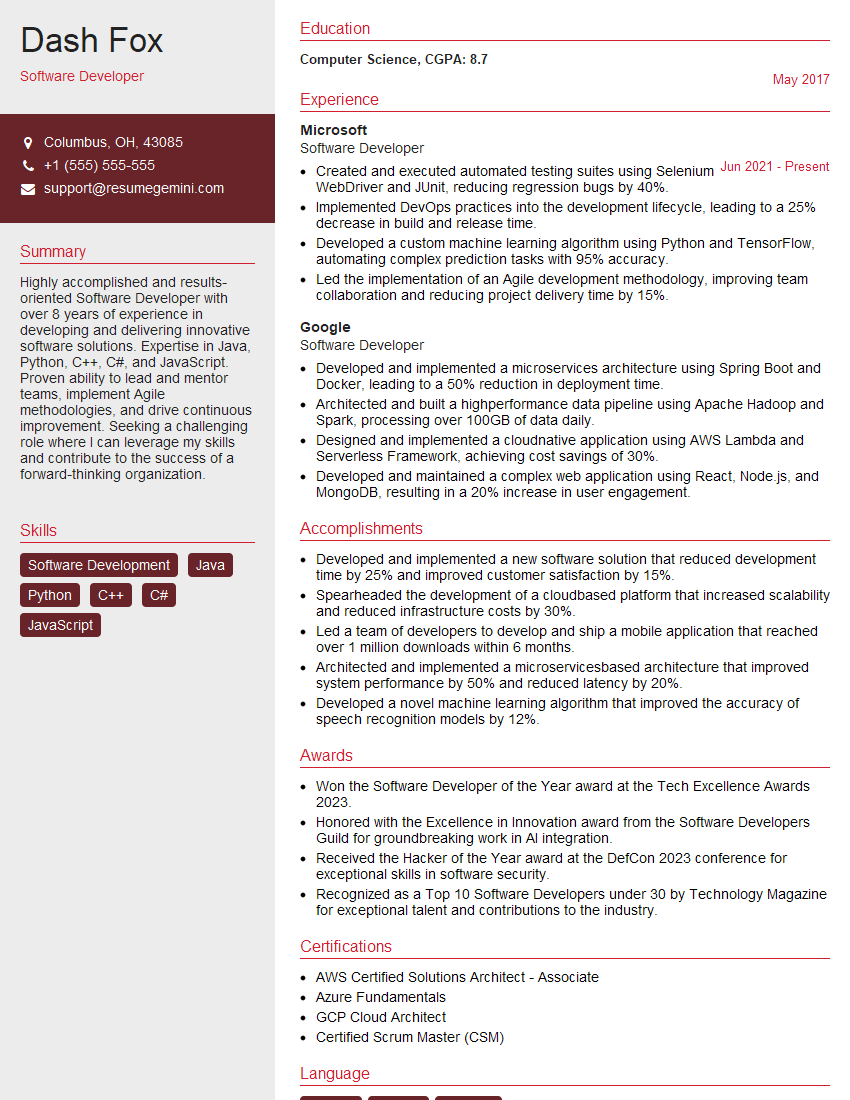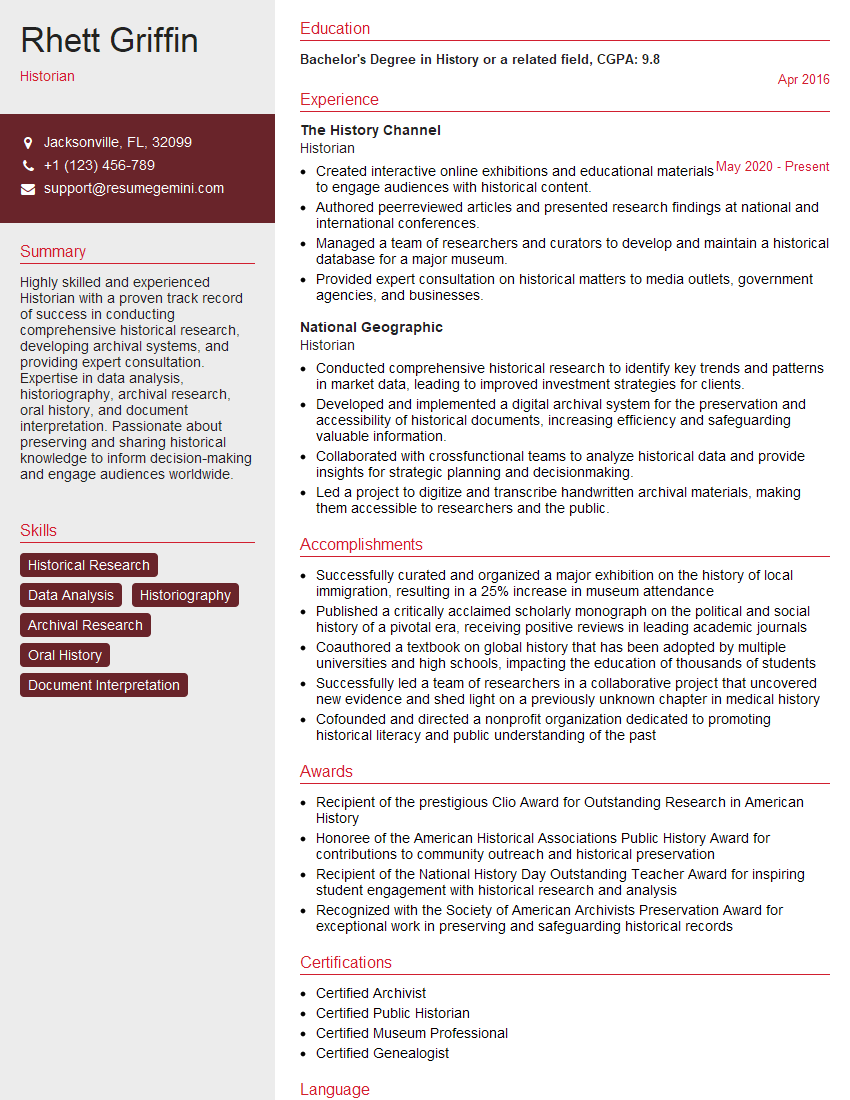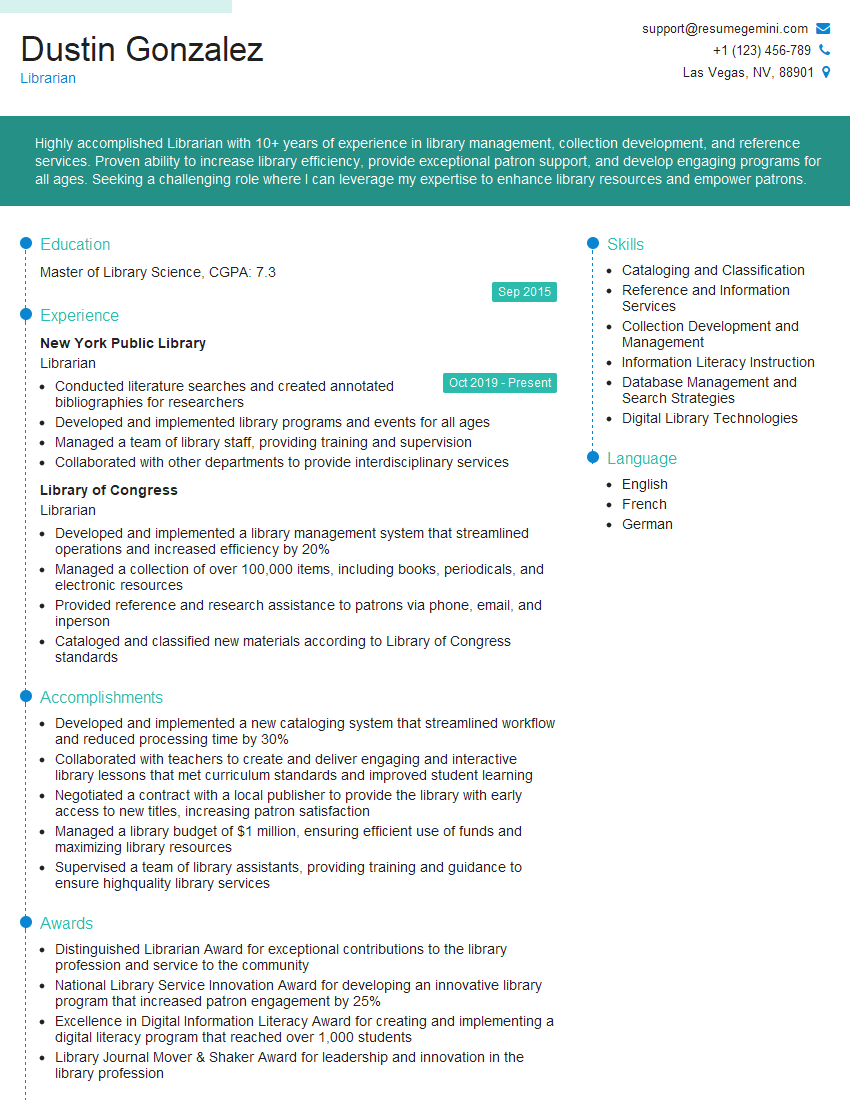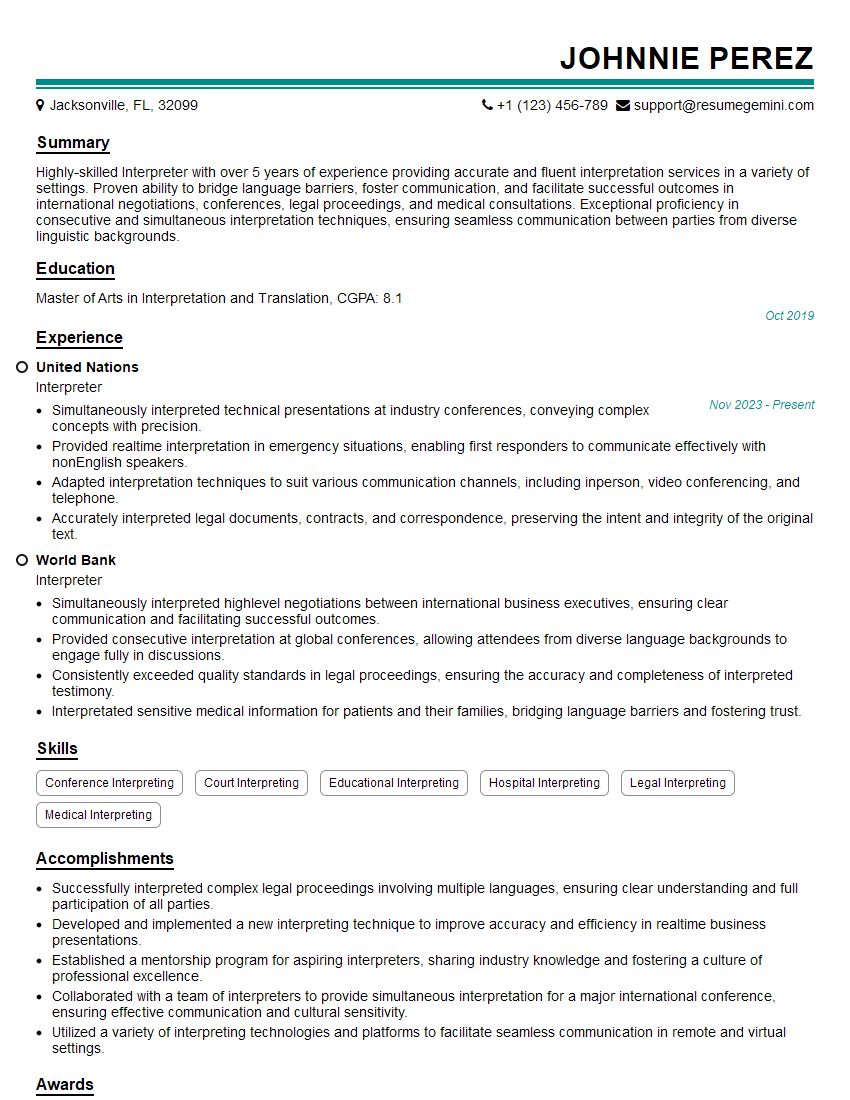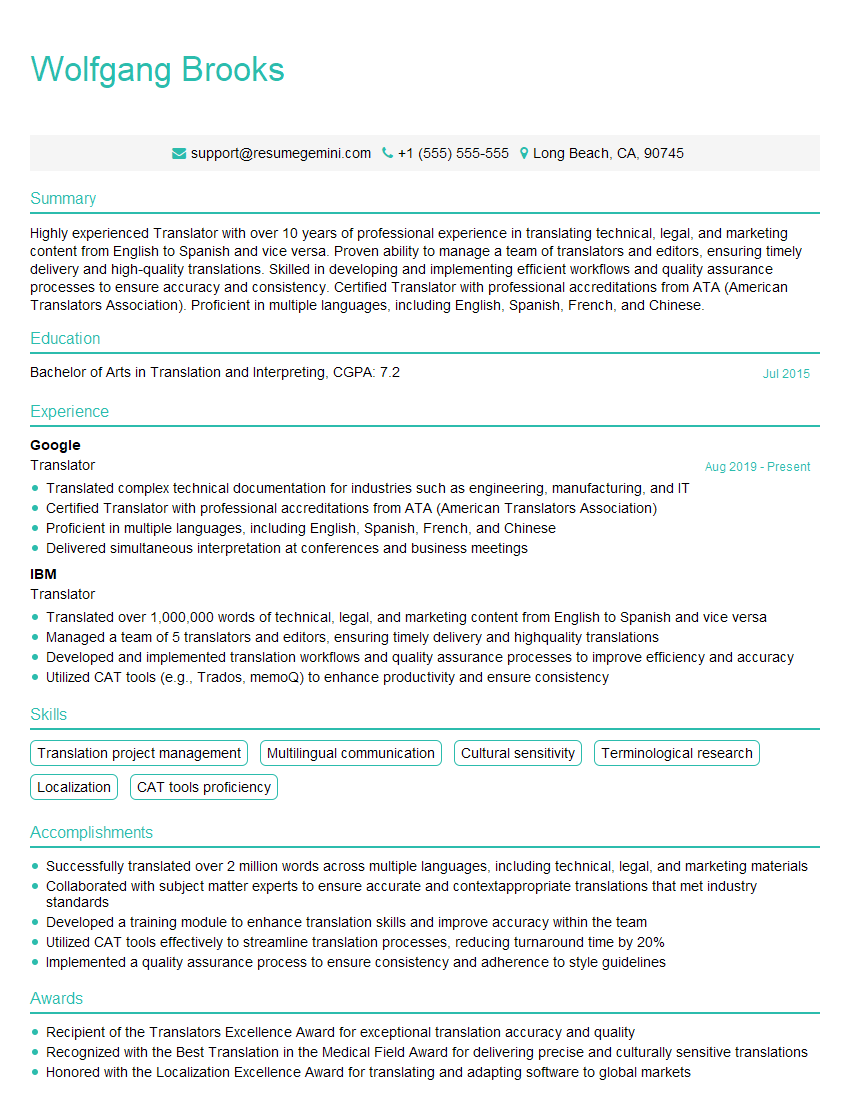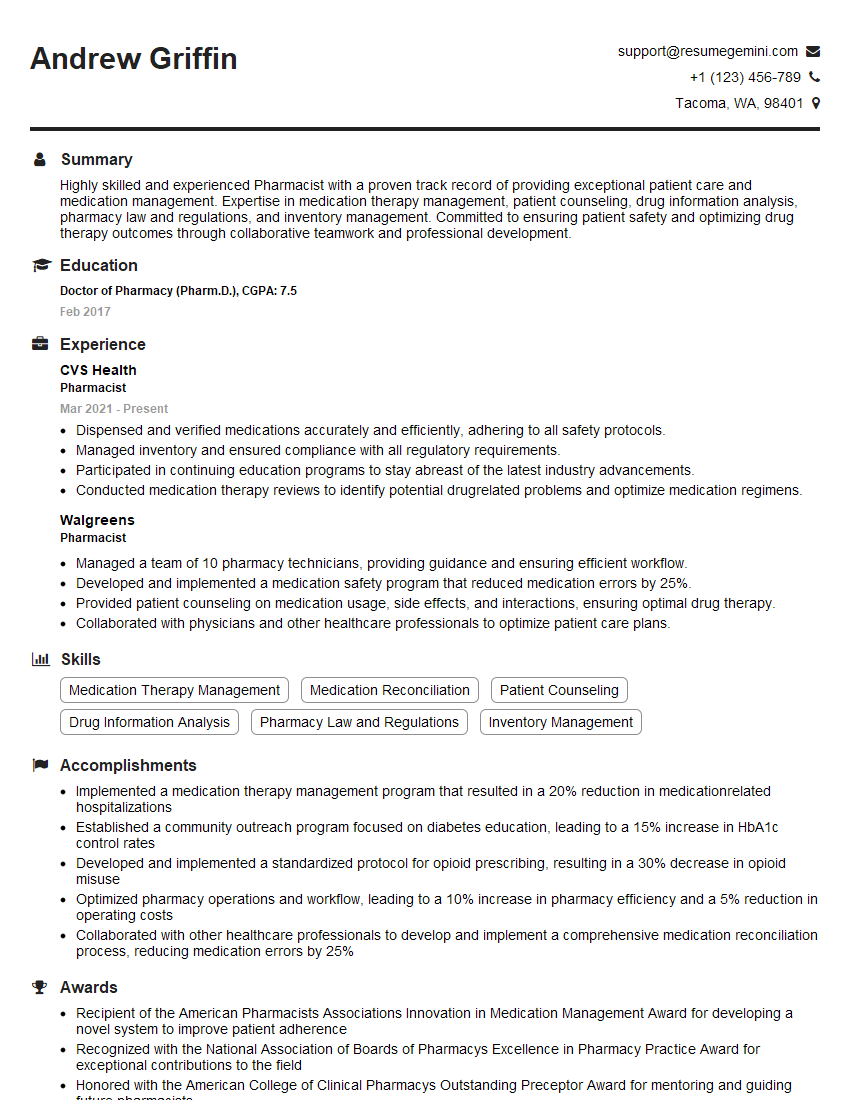Preparation is the key to success in any interview. In this post, we’ll explore crucial Strong memorization and recall skills interview questions and equip you with strategies to craft impactful answers. Whether you’re a beginner or a pro, these tips will elevate your preparation.
Questions Asked in Strong memorization and recall skills Interview
Q 1. Describe a technique you use to memorize large amounts of information.
My primary technique for memorizing large amounts of information centers around the principle of spaced repetition combined with active recall. Instead of passively rereading material, I break it down into manageable chunks and actively test myself on it at increasing intervals. This process strengthens neural pathways and transitions information from short-term to long-term memory more effectively.
For example, if I’m learning a list of historical dates, I might review them after an hour, then again after a day, then after three days, then a week, and so on. Each time, I try to recall the information without looking at my notes. This self-testing is crucial. If I struggle to recall something, I know it needs more attention and further spaced repetition.
I also utilize chunking, grouping related information together to form larger, more meaningful units. This reduces the cognitive load and makes it easier to remember the overall structure.
Q 2. How do you prioritize information for memorization when faced with a large volume?
Prioritizing information for memorization is vital when dealing with a large volume. I employ a strategy based on understanding the importance and relevance of each piece of information. I start by assessing the weight each piece carries towards my overall goal (e.g., exam score, presentation success). I use a combination of methods:
- Identifying key concepts: I focus on the core ideas and principles first, as these often underpin many supporting details.
- Using a hierarchical structure: I organize information into a hierarchical structure, starting with the main topic, then subtopics, and finally supporting details. This helps to see the big picture and the relative importance of different pieces of information.
- Time allocation: I allocate my study time proportionally to the importance and difficulty of each topic. More crucial or challenging concepts receive more focused attention.
For instance, when preparing for a medical exam, I’d prioritize understanding core physiological processes before delving into rarer diseases. This ensures I’ve mastered the fundamentals, maximizing my chances of success.
Q 3. Explain the difference between short-term and long-term memory and how you leverage both.
Short-term memory is like a scratchpad; it holds information temporarily, usually for a few seconds to minutes. Long-term memory, on the other hand, is a vast storage system capable of retaining information for extended periods, sometimes a lifetime. The key to effective memorization lies in seamlessly transferring information from short-term to long-term memory.
I leverage both by using techniques mentioned earlier. Spaced repetition and active recall help consolidate information from short-term memory into long-term storage. Chunking and hierarchical organization improve the efficiency of encoding information into short-term memory, making the transfer to long-term memory smoother. I also incorporate regular review sessions to reinforce what I’ve learned and prevent forgetting.
Think of it like building a house: short-term memory is like gathering the building materials, and long-term memory is the completed structure. Effective techniques ensure a smooth and strong construction.
Q 4. What strategies do you employ to improve your recall of complex details?
Improving recall of complex details involves employing a multi-pronged approach:
- Elaboration: I actively connect new information to what I already know. This creates a rich network of associations, making retrieval easier.
- Visual imagery: I create vivid mental images associated with the information I’m trying to remember. The more bizarre and memorable the image, the better.
- Storytelling: I weave the information into a narrative, creating a memorable story that helps connect the different pieces together.
- Mind mapping: I visually represent concepts and their relationships using mind maps. This provides a holistic overview and facilitates understanding and recall.
For example, when learning about complex biological processes, I might create a visual image of the steps involved, connect it to a personal story, and then create a mind map linking the concepts together. This multi-sensory approach strengthens memory significantly.
Q 5. How do you handle information overload when preparing for a presentation or exam?
Information overload is a common challenge. To handle it effectively, I use a structured approach:
- Break down the material: I divide the overwhelming task into smaller, more manageable sections. This reduces the feeling of being overwhelmed.
- Prioritize based on relevance: I focus on the most important aspects first, ensuring I cover the critical elements before delving into less essential details.
- Time management: I allocate specific time slots for studying different sections and stick to the schedule. This prevents burnout and ensures consistent progress.
- Active learning techniques: I actively engage with the material through techniques like summarizing, teaching it to someone else, or creating practice questions. This enhances understanding and retention.
- Regular breaks: Short breaks throughout the study period are crucial to maintain focus and prevent mental fatigue.
Imagine trying to eat a massive pizza in one sitting. It’s overwhelming! Breaking it down into slices makes it much more manageable. The same principle applies to handling information overload.
Q 6. Describe your experience using mnemonic devices for memorization.
Mnemonic devices are invaluable tools for memorization. I use various types, including:
- Acronyms: For example, ROY G. BIV for the colors of the rainbow (Red, Orange, Yellow, Green, Blue, Indigo, Violet).
- Acrostics: Forming a sentence where the first letter of each word corresponds to the first letter of items on a list.
- Rhymes and songs: Creating rhymes or melodies to associate information with a familiar tune makes it easier to remember.
- Method of Loci (Memory Palace): I associate items on a list with locations in a familiar place, like my house, and then mentally ‘walk through’ that place to recall the items.
I’ve found the Method of Loci particularly effective for memorizing sequences of information, such as historical events or steps in a procedure. It transforms abstract information into a concrete, spatial experience.
Q 7. How do you ensure the accuracy of your recall when dealing with critical information?
Ensuring accuracy when dealing with critical information requires meticulous attention to detail and a multi-layered approach:
- Cross-referencing: I verify information from multiple reputable sources to ensure consistency and accuracy.
- Fact-checking: I carefully scrutinize information for potential errors or biases. This includes checking dates, figures, and citations.
- Documentation: I meticulously document my sources and maintain detailed notes to track the origins of information. This aids in retracing steps if necessary.
- Self-testing and review: Regular self-testing and review helps identify gaps in understanding and potential inaccuracies in my recall.
Accuracy is paramount, particularly in fields dealing with sensitive information. This multi-layered approach minimizes the risk of errors and fosters confidence in the reliability of my recall.
Q 8. Have you ever had to memorize a large dataset? How did you approach it?
Memorizing large datasets requires a structured approach. I wouldn’t try to brute-force it all at once. My strategy involves breaking down the data into manageable chunks and using mnemonic devices. For example, if I needed to memorize a large list of chemical compounds, I wouldn’t try to learn them all in one sitting. Instead, I would divide them into groups based on similar properties (e.g., functional groups, molecular weight ranges). Then, I’d use mnemonic techniques like creating acronyms or vivid imagery to associate each group with a memorable keyword. Finally, I’d use spaced repetition, reviewing the material at increasing intervals to reinforce long-term retention.
For instance, to remember a sequence of numbers like 1492, 1776, 1812, I might visualize historical events associated with each year: Columbus’ voyage, the American Revolution, the War of 1812. This creates a narrative that makes the numbers much easier to recall.
Q 9. How do you adapt your memorization strategies to different types of information (e.g., numbers, names, facts)?
My memorization strategies are highly adaptable. For numbers, I often use techniques like chunking (breaking down long numbers into smaller, more manageable units) and the method of loci (associating numbers with locations in a familiar environment). For names, I focus on creating associations between the name and a memorable feature of the person, perhaps a physical characteristic or a detail from our conversation. For facts, I use techniques like creating mind maps or connecting new information to existing knowledge structures. The key is to find the method that best suits the material and my learning style.
For example, if I’m learning a series of historical dates, I might create a timeline and associate each date with a key event. If I’m memorizing vocabulary, I might use flashcards and create sentences using the new words to embed them in context.
Q 10. What methods do you use to review and reinforce memorized information?
Review and reinforcement are critical for long-term retention. I employ spaced repetition systems, where I review material at increasing intervals. This combats the forgetting curve, which shows that we tend to forget information rapidly unless it’s reviewed. I also use active recall techniques, where I try to retrieve information from memory without looking at the source material. This strengthens memory consolidation. Testing myself regularly, through self-quizzing or using flashcards, is a crucial part of this process.
Imagine learning a new language. Initially, you might review vocabulary every day. As you become more proficient, you can space out your reviews, perhaps reviewing once a week or even once a month. This ensures long-term retention without overwhelming yourself.
Q 11. Describe a time you needed to quickly memorize information under pressure. What was your approach?
Once, I had to quickly memorize a complex presentation containing 20 slides with detailed financial data, graphs and projections for a crucial client meeting. Under pressure, I prioritized the key messages and supporting data points. I used a combination of visual imagery, linking each slide’s key information to a memorable image or story. I also focused on the structure of the presentation itself, creating a mental framework to guide my recall. This allowed me to confidently deliver the presentation even with limited preparation time. Deep breathing and managing my stress levels was also vital.
The key was focusing on the most important elements and connecting them in a way that was easy to retrieve under pressure. Practicing beforehand would have helped even more.
Q 12. How do you deal with forgetting information you previously memorized?
Forgetting is a natural part of memory. When I encounter forgotten information, I don’t get discouraged. Instead, I use this as an opportunity to refine my memorization and retrieval strategies. I go back to the original material, using active recall to try and retrieve the information. If I struggle, I break down the information into smaller chunks and use different mnemonic techniques. Often, revisiting the material in a different context or format can help trigger recall.
Think of it like a muscle. If you haven’t used a muscle in a while, it weakens. The same applies to memory. Consistent use and review are key to strengthening your recall abilities.
Q 13. What techniques do you use to remember names and faces?
Remembering names and faces is a skill that improves with practice. I employ several techniques. First, I make a conscious effort to repeat the person’s name several times during the initial introduction. Then, I try to create an association between the name and the person’s appearance or a unique feature. For example, if I meet someone named ‘Robert’ with a striking red tie, I might mentally link ‘Robert’ with ‘red’ or create a mental image of Robert wearing a flamboyant red tie. I also try to engage in conversation to learn something memorable about the person, which anchors the name to a specific characteristic or anecdote.
The more actively you engage with the person and their name, the more likely you are to remember them.
Q 14. How do you organize information to facilitate easier memorization and recall?
Organizing information is fundamental for effective memorization and recall. I often use mind maps to visually represent relationships between concepts. I also employ outlining and hierarchical structures to break down large amounts of information into smaller, more manageable units. For sequential information, timelines or numbered lists are effective. The choice of organizational method depends on the type of information and the desired outcome. The goal is to create a logical framework that facilitates easy navigation and retrieval.
For example, if I’m studying a historical period, I might create a timeline showing key events. If I’m learning about a complex system, I might create a flowchart to illustrate the relationships between its components.
Q 15. Explain your understanding of memory palaces or other spatial memory techniques.
Memory palaces, also known as the method of loci, are a powerful mnemonic technique that leverages our spatial memory to enhance recall. Essentially, you create a familiar route or location – a ‘palace’ – in your mind, and then associate items you want to remember with specific locations along that route. The more vivid and unusual the associations, the better your memory will be.
For example, imagine your childhood home. You might associate the first item on your list with your front door, the second with the living room couch, the third with the kitchen table, and so on. When you need to recall the list, you mentally walk through your house, retrieving each item based on its associated location. This method works exceptionally well because our brains are wired to remember spatial information very effectively.
Beyond houses, you can create a memory palace using any familiar route – your daily commute, a street you frequently walk, or even a fantastical imaginary journey. The key is to choose a route with distinct, memorable landmarks to act as ‘hooks’ for your information.
Career Expert Tips:
- Ace those interviews! Prepare effectively by reviewing the Top 50 Most Common Interview Questions on ResumeGemini.
- Navigate your job search with confidence! Explore a wide range of Career Tips on ResumeGemini. Learn about common challenges and recommendations to overcome them.
- Craft the perfect resume! Master the Art of Resume Writing with ResumeGemini’s guide. Showcase your unique qualifications and achievements effectively.
- Don’t miss out on holiday savings! Build your dream resume with ResumeGemini’s ATS optimized templates.
Q 16. How do you utilize spaced repetition to improve long-term retention?
Spaced repetition is a learning technique based on the psychological spacing effect. It involves reviewing information at increasing intervals. The idea is that by revisiting material just before you’re about to forget it, you strengthen the memory trace and move it from short-term to long-term memory.
I utilize spaced repetition software and flashcards. I start by reviewing new information frequently (e.g., every few hours), gradually increasing the intervals between reviews. For example, if I’m learning a list of vocabulary words, I might review them every hour on the first day, every three hours the next, then every day, then every three days, and so on. This schedule ensures that I’m consistently reinforcing my memory without wasting time on material I already know well. The timing is crucial; reviewing too soon is inefficient, and reviewing too late risks forgetting altogether.
Q 17. What role does sleep play in your memorization and recall processes?
Sleep plays a crucial role in memory consolidation. During sleep, particularly during REM (Rapid Eye Movement) sleep, the brain processes and organizes information acquired throughout the day. This process transfers memories from the hippocampus (the brain’s temporary memory storage area) to the neocortex (the long-term storage area).
Adequate sleep is therefore essential for effective memorization and recall. If I’m trying to memorize something important, I ensure I get a good night’s rest before the recall. Sleep deprivation impairs memory consolidation, leading to poorer recall and increased difficulty in learning new information. I also find that napping can be beneficial for boosting memory, especially if the nap occurs after a learning session.
Q 18. How do you overcome distractions while trying to memorize something?
Overcoming distractions is paramount for effective memorization. My approach is multifaceted. First, I actively create a distraction-free environment. This often involves finding a quiet space, turning off notifications on my electronic devices, and letting those around me know I need uninterrupted time.
Secondly, I use techniques like the Pomodoro Technique, working in focused bursts (e.g., 25 minutes) followed by short breaks. This helps maintain concentration. If distractions inevitably pop up, I acknowledge them without judgment, briefly note them down, and gently redirect my focus back to the memorization task. Mindfulness exercises are helpful in improving my ability to manage these interruptions. Essentially, it’s about developing a strong focus and practicing strategies to redirect attention when necessary.
Q 19. How do you use visual aids to enhance your memory?
Visual aids are invaluable for enhancing memory. My brain processes visual information exceptionally well. I use various visual aids depending on the material. For example, when learning geographical locations, I use maps and satellite imagery. For complex concepts, I create diagrams, flowcharts, or mind maps. For lists of items, I create visual metaphors or stories connecting the items through imagery.
I find that transforming information into a visual format makes it more engaging and memorable. The more vivid and unusual the image, the better the recall. For example, if I need to remember a series of historical events, I might create a mental movie scene depicting each event with exaggerated visual cues. The more sensory detail I incorporate – sights, sounds, smells, textures – the stronger the memory trace becomes.
Q 20. What is your preferred method for memorizing sequences of numbers or data points?
My preferred method for memorizing sequences of numbers or data points involves chunking and mnemonic techniques. Chunking involves breaking down large sequences into smaller, manageable units. For example, a long phone number (e.g., 555-123-4567) can be chunked into three parts: 555, 123, and 4567.
Then, I use mnemonics to make these chunks more memorable. This could involve associating each chunk with a word, image, or phrase. For example, 555 could become ‘triple five,’ which I might visualize as three fives stacked on top of each other. Or I might use the phonetic system, converting numbers into similar-sounding letters to form words (number-to-letter mnemonics). The key is creating strong associations to enhance recall. With practice, this method allows for efficient memorization of even very long numerical sequences.
Q 21. Describe a time your memory skills helped you solve a problem.
During a critical project involving the analysis of a vast dataset, we needed to identify specific patterns and anomalies quickly. The dataset was enormous, and conventional analysis methods were proving slow and inefficient. My strong memory skills allowed me to quickly absorb key data points and identify potential trends that would have been easily missed by others.
I visualized the dataset as a three-dimensional map in my mind, associating key data points with specific locations on this mental map. This allowed me to rapidly recall specific relationships between data points, identify crucial outliers, and formulate hypotheses much faster than through conventional means. This rapid analysis helped us identify a critical error in the data collection process, saving the project from significant setbacks. The ability to quickly recall and process information in a visual format was crucial to the successful resolution of this problem.
Q 22. How do you manage the retention of information over extended periods?
Long-term retention hinges on a multi-pronged approach combining active recall, spaced repetition, and elaborative encoding. Think of your memory like a muscle; the more you use it, the stronger it gets.
Active Recall: Instead of passively rereading material, I actively test myself. This could involve using flashcards, self-testing with practice questions, or teaching the material to someone else. This forces my brain to actively retrieve the information, strengthening the memory trace.
Spaced Repetition: I don’t cram information all at once. Instead, I review the material at increasing intervals – starting with frequent reviews shortly after learning, and gradually spacing them out over time. This combats the forgetting curve, ensuring long-term retention.
Elaborative Encoding: I connect new information to existing knowledge. I create mental associations, using mnemonics, visual imagery, and storytelling to weave new facts into a rich tapestry of understanding. For instance, if learning about historical dates, I might link them to personal events or create a vivid mental image.
For example, when learning a new programming language, I wouldn’t just read the syntax. I’d write code examples, test them, and then revisit the code and concepts at increasing intervals, strengthening my understanding and making the information readily available.
Q 23. How do you differentiate between facts and opinions when memorizing information?
Differentiating between facts and opinions is crucial for accurate recall. Facts are verifiable statements supported by evidence, while opinions are subjective beliefs or judgments.
When memorizing, I employ a critical thinking approach. I actively seek out verifiable sources to confirm the validity of a statement. If a statement lacks credible evidence or is presented as someone’s belief, I label it as an opinion, acknowledging its subjective nature.
For example, “The Earth is round” is a fact supported by scientific evidence. “The best programming language is Python” is an opinion, reflecting individual preference. By actively questioning the source and evidence behind each piece of information, I maintain the integrity of my memory.
Q 24. Explain the concept of chunking and how you apply it to improve memorization.
Chunking involves grouping individual pieces of information into larger, more manageable units. This significantly improves memorization by reducing cognitive load. It’s like organizing items into boxes instead of having a chaotic jumble.
I apply chunking in various ways. For example, when memorizing a phone number, instead of remembering each digit individually (1-2-3-4-5-6-7-8-9-0), I group them into smaller chunks: 123-456-7890. This makes the information easier to recall.
In more complex scenarios, like memorizing a historical timeline, I might chunk events by decade or reign, linking related events together to create cohesive narratives. The key is to create meaningful chunks that logically relate to one another.
Q 25. How do you ensure the integrity of information you recall, particularly sensitive information?
Ensuring the integrity of recalled information, especially sensitive data, requires rigorous attention to detail and secure practices. This includes utilizing robust memory techniques, practicing mindful recall, and adhering to security protocols.
Secure Storage: For sensitive information, I avoid relying solely on memory. Instead, I use secure digital storage, employing strong passwords and encryption. I might also utilize password managers to reduce risks associated with remembering numerous passwords.
Mindful Recall: When recalling sensitive information, I carefully check my recollection against reliable sources. This helps prevent accidental misremembering or unintentional disclosure.
Data Minimization: I only memorize the necessary details, avoiding unnecessary memorization of overly sensitive information that may compromise security if recalled incorrectly.
For instance, if dealing with client financial details, I would record that information in a secure system and only retain necessary details in my memory, to minimize risk.
Q 26. How do you handle conflicting information when attempting to memorize data?
Conflicting information can be challenging, but resolving it is crucial for accurate memory. My approach involves triangulation and critical evaluation.
Triangulation: I seek multiple reliable sources to verify information. If two sources conflict, I investigate further to identify the most credible source. I look for evidence and consistency across multiple sources.
Critical Evaluation: I assess the credibility of each source, considering its expertise, potential biases, and the methodology used. This helps me to identify and prioritize reliable information.
For example, when researching a historical event, I would consult multiple reputable academic sources. If sources conflict, I might dig deeper, looking for primary sources or examining the authors’ biases to understand the discrepancies.
Q 27. What are some limitations of your memory and how do you mitigate them?
Even with strong memory skills, limitations exist. Everyone has a capacity limit, and certain factors like stress, sleep deprivation, and age can impact recall.
Capacity Limitations: I acknowledge that I can’t perfectly remember everything. Instead of trying to memorize everything, I prioritize key information and use external tools like notes and databases to supplement my memory.
Mitigation Strategies: I manage these limitations by:
- Prioritizing sleep and managing stress
- Using effective memory techniques like chunking and spaced repetition
- Employing external memory aids like note-taking and organizational systems
- Regularly reviewing and consolidating information
Understanding my limitations allows me to work smarter, not harder. I embrace tools and strategies that help me overcome these natural memory constraints.
Q 28. How do you evaluate the effectiveness of different memorization strategies?
Evaluating the effectiveness of memorization strategies involves tracking recall accuracy and efficiency over time. I use a combination of self-assessment, feedback, and data-driven approaches.
Self-Assessment: After learning new information, I regularly test myself using various methods like flashcards or practice questions. I track my success rate to assess my understanding.
Feedback: When applicable, I seek feedback from others on my recall accuracy. This external perspective can highlight areas where my memory strategies are lacking.
Data-Driven Approach: For complex memorization tasks, I might use data-tracking techniques to monitor progress. This could include logging the time spent studying, the number of successful recalls, and the intervals between reviews.
Through continuous monitoring and adjustment, I refine my strategies for optimal memorization.
Key Topics to Learn for Strong Memorization and Recall Skills Interview
- Mnemonics and Memory Techniques: Explore various mnemonic devices like acronyms, acrostics, and keyword methods to enhance memorization and recall of information.
- Chunking and Organization: Learn how to break down large amounts of information into smaller, manageable chunks and organize them logically for easier retention and retrieval.
- Active Recall and Spaced Repetition: Understand the power of active recall through practice tests and quizzes, and implement spaced repetition techniques to optimize learning and retention over time.
- Memory Palace Technique (Method of Loci): Discover this powerful visualization technique to associate information with familiar locations, strengthening memory connections.
- Understanding Different Memory Types: Explore the distinctions between short-term, long-term, sensory, and working memory to tailor your learning strategies for optimal effectiveness.
- Practical Application: Case Studies and Scenarios: Practice applying your memory skills to real-world scenarios, such as recalling complex data sets, procedures, or client information. Consider how you’ve successfully used these skills in past experiences.
- Improving Focus and Concentration: Develop strategies to minimize distractions and enhance your ability to concentrate during learning and recall phases. This includes managing stress and optimizing your learning environment.
- Identifying and Overcoming Memory Challenges: Understand common memory obstacles (e.g., anxiety, poor sleep) and implement strategies to mitigate their impact on your recall abilities.
Next Steps
Mastering strong memorization and recall skills is crucial for career advancement across numerous fields, enabling you to excel in roles demanding detailed knowledge retention and efficient information processing. A strong resume highlighting these capabilities is essential for attracting the attention of recruiters and landing your dream job. To present your skills effectively, create an ATS-friendly resume that clearly showcases your achievements and experience. ResumeGemini is a trusted resource to help you build a professional and impactful resume that emphasizes your strengths. Examples of resumes tailored to highlight strong memorization and recall skills are available to help guide you.
Explore more articles
Users Rating of Our Blogs
Share Your Experience
We value your feedback! Please rate our content and share your thoughts (optional).
What Readers Say About Our Blog
Hello,
We found issues with your domain’s email setup that may be sending your messages to spam or blocking them completely. InboxShield Mini shows you how to fix it in minutes — no tech skills required.
Scan your domain now for details: https://inboxshield-mini.com/
— Adam @ InboxShield Mini
Reply STOP to unsubscribe
Hi, are you owner of interviewgemini.com? What if I told you I could help you find extra time in your schedule, reconnect with leads you didn’t even realize you missed, and bring in more “I want to work with you” conversations, without increasing your ad spend or hiring a full-time employee?
All with a flexible, budget-friendly service that could easily pay for itself. Sounds good?
Would it be nice to jump on a quick 10-minute call so I can show you exactly how we make this work?
Best,
Hapei
Marketing Director
Hey, I know you’re the owner of interviewgemini.com. I’ll be quick.
Fundraising for your business is tough and time-consuming. We make it easier by guaranteeing two private investor meetings each month, for six months. No demos, no pitch events – just direct introductions to active investors matched to your startup.
If youR17;re raising, this could help you build real momentum. Want me to send more info?
Hi, I represent an SEO company that specialises in getting you AI citations and higher rankings on Google. I’d like to offer you a 100% free SEO audit for your website. Would you be interested?
Hi, I represent an SEO company that specialises in getting you AI citations and higher rankings on Google. I’d like to offer you a 100% free SEO audit for your website. Would you be interested?
good








